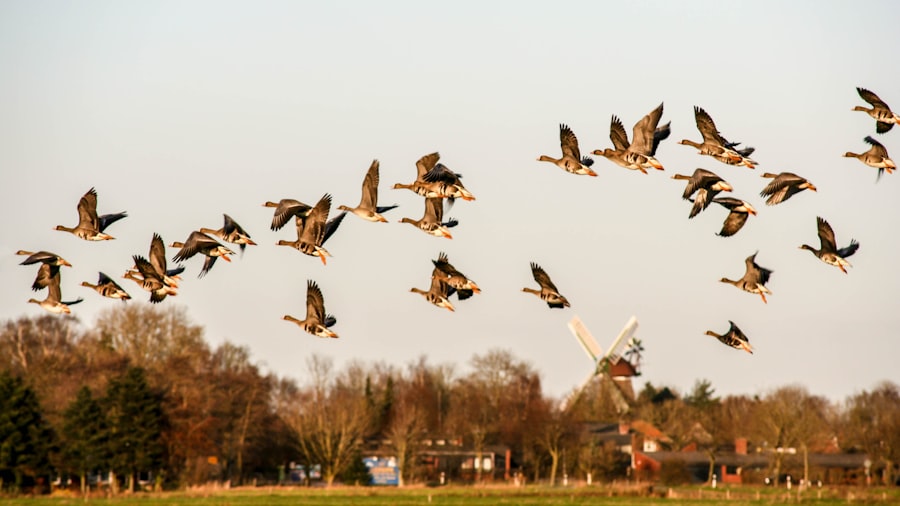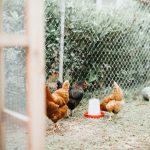Keeping chickens and ducks together can be a beneficial practice for poultry enthusiasts. Both species are popular choices for backyard flocks, and their combination can create a diverse and productive coop environment. Chickens are primarily valued for their egg-laying capabilities and ability to control pests, while ducks are appreciated for their pest control abilities, meat production, and egg-laying potential.
Integrating chickens and ducks in a single flock allows poultry keepers to maximize the advantages of both species. When considering a mixed flock of chickens and ducks, it is essential to understand the compatibility between these two species. Although chickens and ducks have distinct needs and behavioral patterns, they can coexist harmoniously with proper planning and management.
To ensure a successful mixed flock, poultry keepers should focus on several key aspects:
1. Coop design: Creating a living space that accommodates the specific requirements of both chickens and ducks. 2.
Nutrition: Providing appropriate feed and water sources for each species. 3. Health and hygiene: Implementing proper sanitation practices and monitoring for potential health issues.
4. Behavioral management: Addressing any challenges that may arise from the different social structures and habits of chickens and ducks. By carefully considering these factors, poultry keepers can establish a thriving mixed flock that offers a range of benefits and enhances their overall poultry-keeping experience.
Table of Contents
- 1 Understanding the Compatibility of Chickens and Ducks
- 2 Designing a Coop for Chickens and Ducks
- 3 Feeding and Watering Considerations for Mixed Flocks
- 4 Managing Health and Hygiene in a Mixed Coop
- 5 Addressing Behavioral Challenges in Combined Flocks
- 6 Enjoying the Benefits of Keeping Chickens and Ducks Together
- 7 FAQs
- 7.1 Can chickens and ducks live together in the same coop?
- 7.2 What are the benefits of keeping chickens and ducks together?
- 7.3 What are the challenges of keeping chickens and ducks together?
- 7.4 How can I ensure the safety of both chickens and ducks in the same coop?
- 7.5 What should I consider before keeping chickens and ducks together?
Key Takeaways
- Chickens and ducks can be kept together, but it requires careful planning and consideration of their compatibility, coop design, feeding and watering, health and hygiene, and behavioral challenges.
- Understanding the compatibility of chickens and ducks is important, as they have different social structures, dietary needs, and behaviors that can impact their ability to coexist peacefully.
- When designing a coop for chickens and ducks, it’s important to provide separate nesting areas, perches, and access to water to accommodate their different needs.
- Feeding and watering considerations for mixed flocks involve providing appropriate feed and ensuring access to clean water for both chickens and ducks.
- Managing health and hygiene in a mixed coop requires regular cleaning, monitoring for signs of illness, and providing appropriate shelter and protection from predators for both chickens and ducks.
Understanding the Compatibility of Chickens and Ducks
Understanding Their Differences
Chickens are ground-dwelling birds that prefer to scratch and peck for food, while ducks are more aquatic and enjoy dabbling in water. Despite these differences, chickens and ducks can share the same coop space if provided with appropriate accommodations.
Selecting Compatible Breeds
It’s essential to consider the size and temperament of both chicken and duck breeds when planning a mixed flock. Some breeds may be more compatible than others. In general, ducks are more cold-hardy than chickens and are less prone to respiratory issues, making them well-suited for cohabitating with chickens. However, ducks can be messier than chickens due to their water-loving nature, so providing adequate drainage and bedding in the coop is crucial.
Meeting Their Dietary Needs
Ducks may have different dietary requirements than chickens, so it’s vital to provide a balanced feed that meets the nutritional needs of both species. By understanding the compatibility of chickens and ducks and making thoughtful decisions about breed selection and coop design, poultry keepers can create a successful mixed flock that benefits from the strengths of both species.
Designing a Coop for Chickens and Ducks

When keeping chickens and ducks together, it’s important to design a coop that meets the needs of both species. The coop should provide ample space for both chickens and ducks to roost, nest, and move around comfortably. Additionally, the coop should include separate areas for feeding and watering to accommodate the different dietary preferences of chickens and ducks.
Providing adequate ventilation and natural light in the coop is essential for maintaining good air quality and promoting overall health. Incorporating appropriate bedding materials in the coop is important for managing the messiness of ducks and providing a comfortable environment for both species. For ducks, providing access to water for swimming and dabbling is essential for their well-being, so including a small pond or shallow water source within the coop or run area is beneficial.
When designing a coop for chickens and ducks, it’s important to consider the unique needs of each species while also providing opportunities for them to interact and socialize. By creating a well-designed coop that meets the needs of both chickens and ducks, poultry keepers can promote a harmonious and productive mixed flock.
Feeding and Watering Considerations for Mixed Flocks
Feeding and watering considerations are important when keeping chickens and ducks together in a mixed flock. While both chickens and ducks require a balanced diet to support their health and productivity, they may have different dietary preferences and nutritional needs. Chickens are omnivores that primarily eat grains, seeds, insects, and kitchen scraps, while ducks are dabbling birds that enjoy foraging for insects, aquatic plants, and small fish in addition to a commercial feed.
When feeding a mixed flock of chickens and ducks, it’s important to provide a balanced feed that meets the nutritional requirements of both species. Additionally, offering separate feeding areas for chickens and ducks can help prevent competition for food and ensure that each species receives an adequate amount of feed. Providing access to clean water is essential for both chickens and ducks, but ducks have a greater need for water due to their aquatic nature.
Ducks should have access to water for swimming and dabbling, while chickens require access to clean drinking water at all times. Managing feeding and watering considerations for mixed flocks requires careful planning and observation to ensure that both chickens and ducks receive the nutrition they need to thrive. By providing appropriate feed and water options for both species and monitoring their consumption, poultry keepers can promote the health and productivity of their mixed flock.
Managing Health and Hygiene in a Mixed Coop
Maintaining good health and hygiene in a mixed coop is essential for promoting the well-being of both chickens and ducks. Chickens and ducks are susceptible to different diseases and parasites, so implementing a proactive health management plan is important for preventing illness and maintaining a healthy flock. Regularly cleaning the coop, providing fresh bedding, and managing waste effectively can help reduce the risk of disease transmission and promote overall hygiene.
Additionally, monitoring the health of both chickens and ducks on a regular basis can help identify any signs of illness or injury early on. Providing access to veterinary care when needed is important for addressing any health concerns that may arise in a mixed flock. In addition to managing health considerations, maintaining good hygiene in the coop is important for preventing the buildup of bacteria and pathogens that can lead to illness in poultry.
By implementing a proactive health management plan and maintaining good hygiene practices in the coop, poultry keepers can create a healthy environment for their mixed flock of chickens and ducks.
Addressing Behavioral Challenges in Combined Flocks

Chickens and ducks have different social structures and communication styles, which can lead to conflicts if not addressed. Chickens are known for their hierarchical pecking order, while ducks are more laid-back and social. Observing their interactions closely is crucial to identify any potential issues early on.
Minimizing Competition and Conflict
Providing adequate space and resources is essential to minimize competition and conflict between chickens and ducks. Ensuring that each bird has access to food, water, and shelter can reduce aggression and territorial behavior. Additionally, introducing new birds to an existing flock should be done gradually to prevent disruptions to the social dynamics.
Environmental Enrichment
Environmental enrichment activities can play a significant role in reducing boredom and aggression in a mixed flock. Providing perches, dust bathing areas, and access to natural vegetation can help keep birds engaged and stimulated. By addressing behavioral challenges proactively and providing a well-designed environment, poultry keepers can promote harmonious interactions within their mixed flock.
Enjoying the Benefits of Keeping Chickens and Ducks Together
Keeping chickens and ducks together in a mixed flock can offer a range of benefits for poultry enthusiasts. By understanding the compatibility of these two species, designing a coop that meets their needs, managing feeding, health, hygiene considerations, addressing behavioral challenges, poultry keepers can create a successful mixed flock that offers the strengths of both chickens and ducks. With proper planning and management, keeping chickens and ducks together can be a rewarding experience that provides opportunities for egg production, pest control, meat production, and enjoyment of diverse poultry species.
By creating a well-designed environment that meets the needs of both chickens and ducks while promoting harmonious interactions within the mixed flock, poultry keepers can enjoy the benefits of keeping these two species together in their backyard coop. With careful planning, observation, and proactive management practices, poultry keepers can create a thriving mixed flock that offers a dynamic and diverse poultry experience.
If you’re considering keeping chickens and ducks in the same coop, you may also be interested in learning about the compatibility of geese and chickens. Poultry Wizard has an article discussing whether geese can eat chicken feed, which can provide valuable insights into the dietary needs and interactions of different poultry species. Check it out here.
FAQs
Can chickens and ducks live together in the same coop?
Yes, chickens and ducks can live together in the same coop as long as there is enough space for both species and proper management of their different needs.
What are the benefits of keeping chickens and ducks together?
Keeping chickens and ducks together can provide companionship for the animals, reduce loneliness, and increase overall coop activity. Additionally, ducks can help control pests in the coop and chickens can help keep the coop clean.
What are the challenges of keeping chickens and ducks together?
Chickens and ducks have different dietary and environmental needs, so it can be challenging to provide suitable conditions for both species in the same coop. Additionally, ducks may create a mess with their water needs, which can be a challenge to manage in a shared coop.
How can I ensure the safety of both chickens and ducks in the same coop?
To ensure the safety of both chickens and ducks in the same coop, it’s important to provide separate nesting areas, feeding stations, and water sources for each species. Additionally, monitoring their interactions and behavior can help prevent any potential conflicts.
What should I consider before keeping chickens and ducks together?
Before keeping chickens and ducks together, consider the space requirements, dietary needs, and environmental preferences of each species. It’s important to ensure that the coop and outdoor area can accommodate both chickens and ducks comfortably.
Meet Walter, the feathered-friend fanatic of Florida! Nestled in the sunshine state, Walter struts through life with his feathered companions, clucking his way to happiness. With a coop that’s fancier than a five-star hotel, he’s the Don Juan of the chicken world. When he’s not teaching his hens to do the cha-cha, you’ll find him in a heated debate with his prized rooster, Sir Clucks-a-Lot. Walter’s poultry passion is no yolk; he’s the sunny-side-up guy you never knew you needed in your flock of friends!







